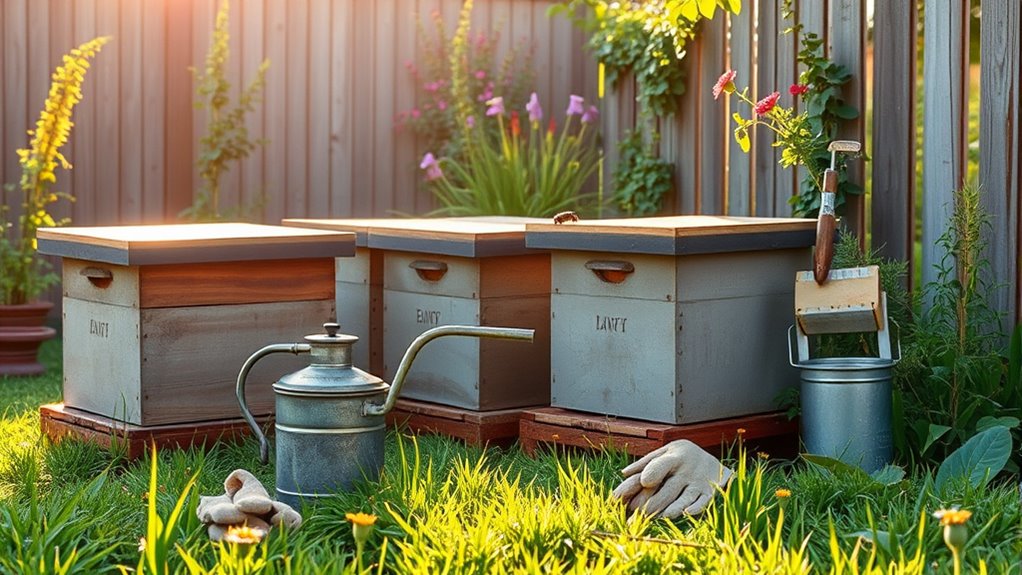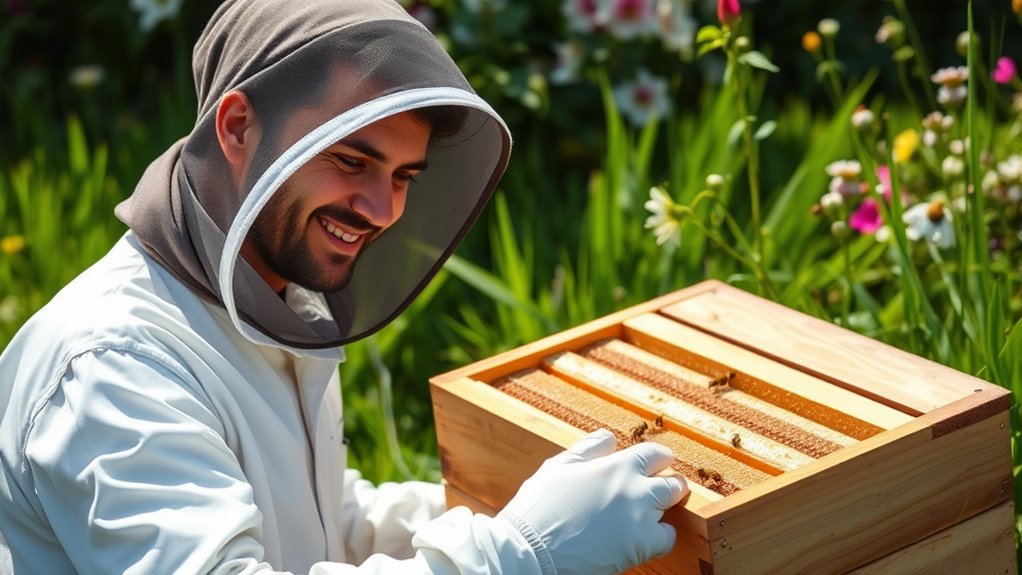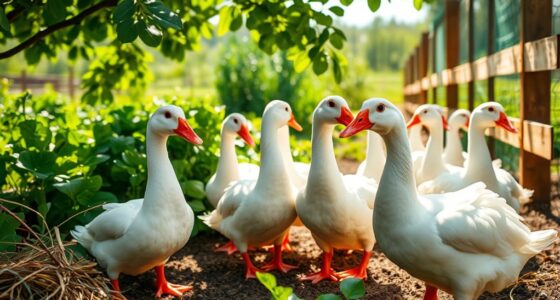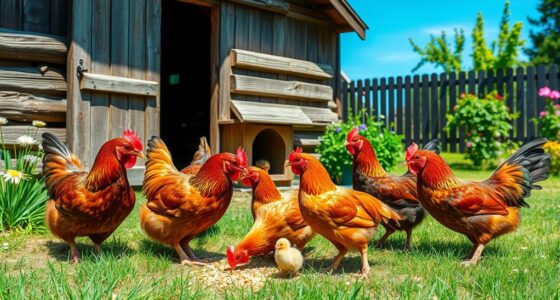Starting backyard beekeeping is simpler than you might think. Begin by understanding hive components like brood boxes, honey supers, and frames. Regular inspections help keep your bees healthy and productive, allowing you to monitor for signs of disease and guarantee they have enough space. Keep everything clean and organized to prevent pests. As you learn to manage your hive, you’ll discover how to harvest honey and support your bees. If you keep going, you’ll open more tips for successful beekeeping.
Key Takeaways
- Understand hive components and their functions to set up a suitable environment for bees.
- Conduct regular hive inspections to monitor bee health and prevent diseases.
- Harvest honey once honey supers are filled and capped, using proper tools and techniques.
- Maintain hive cleanliness and organization to reduce pests and promote healthy bees.
- Develop patience and observation skills to adapt management practices and support thriving bee colonies.

Ever wondered how you can turn your backyard into a thriving hive of activity? Starting backyard beekeeping might seem daunting at first, but with a little guidance, you’ll find it both rewarding and manageable. The first step involves understanding the basics of hive maintenance, which is crucial to keeping your bees healthy and productive. Regular hive maintenance means inspecting your hive periodically to check for signs of disease, ensuring the bees have enough space, and replacing or adding frames when necessary. It’s essential to get familiar with the different parts of the hive, such as the brood box, honey super, and frames, so you know what to look for during your inspections. Keeping the hive clean and well-organized helps prevent pests and diseases, making hive maintenance a routine that becomes second nature with experience. Additionally, understanding and implementing the principles of the Law of Attraction can help foster a positive mindset and patience as you learn beekeeping skills.
Once your hive is established and healthy, you’ll start thinking about honey harvesting. This is one of the most exciting parts of backyard beekeeping. When your bees have filled the honey supers with capped honey—indicating it’s ready—you can carefully remove the frames. Using a hive tool, gently lift the frames out of the hive, being cautious not to disturb the bees unnecessarily. The honey is then extracted by uncapping the honeycomb cells with a heated knife or an uncapping fork, allowing the honey to flow freely into a extractor. Spin the frames in the extractor to separate honey from the wax comb, then strain the honey to remove any debris. The process of honey harvesting is both satisfying and straightforward, but it’s important to handle the hive and the honey with care to avoid stressing the bees. Familiarity with hive parts ensures efficient honey extraction and maintenance. Developing a good understanding of hive structure can help you troubleshoot and prevent common issues early on. Remember that hive health is essential for sustained honey production and bee well-being, so regular checks are vital. Incorporating risk management strategies can help you prepare for unexpected challenges in your beekeeping journey.
Throughout this process, remember that hive maintenance and honey harvesting go hand in hand. Regular inspections ensure your hive remains healthy and productive, while timely honey harvesting allows you to enjoy the fruits of your bees’ labor. Be patient and observant—each hive has its rhythm, and learning to read the bees’ signals will improve your success over time. As you gain experience, you’ll develop a routine that minimizes disruption to the hive and maximizes honey production. Backyard beekeeping isn’t just about collecting honey; it’s about creating a balanced environment where bees can thrive, and you can enjoy the remarkable process of nurturing these vital pollinators.
Frequently Asked Questions
What Is the Optimal Time of Year to Start Beekeeping?
You should start beekeeping in spring when seasonal nectar is abundant, giving your hive the best chance to grow strong. This timing allows you to perform hive maintenance effectively, ensuring your bees have enough resources for the season. Beginning then also means you can monitor hive health and prevent issues early. Starting at the right time helps your bees thrive, making your beekeeping journey more successful and rewarding.
How Much Does a Beginner Beekeeping Setup Typically Cost?
When considering your beginner beekeeping setup, the cost estimate can vary, but generally, you’ll spend between $200 and $500. This covers equipment essentials like a hive, protective gear, and tools. You might find starter kits that include everything you need, which can be more affordable. Keep in mind, investing in quality equipment guarantees safety and a better experience, making it a worthwhile initial expense.
Are There Any Legal Restrictions for Backyard Beekeeping?
Imagine your backyard buzzing with life, bees flitting from flower to hive. Before you start, check your local regulations and zoning laws, as they often set rules for backyard beekeeping. Some areas require permits or impose restrictions on hive placement. Knowing these laws helps you avoid fines and keeps your buzzing sanctuary compliant. Always research your local rules, so your beekeeping journey remains smooth and enjoyable.
How Do I Attract Bees to My Backyard?
To attract bees to your backyard, focus on creating a welcoming environment. Plant a variety of native flowers and plants to guarantee a diverse nectar and pollen source, which appeals to different bee species. Include water sources like shallow dishes with pebbles or birdbaths for hydration. Keep your yard pesticide-free and provide shelter, such as bee hotels, to encourage bees to settle and thrive.
What Are Common Signs of a Healthy Hive?
Think of your hive as a bustling city. When you do a hive inspection, look for lively bee activity—bees constantly coming and going, workers tending to cells, and the queen moving freely. A healthy hive buzzes with activity, has clean, capped brood, and stores plenty of honey. These signs show your hive’s thriving, and regular checks help you spot issues early, keeping your bee city strong and lively.
Conclusion
As you step into the world of backyard beekeeping, think of yourself as the gentle gardener tending a bustling hive of life. With each careful move, you nurture a tiny universe buzzing with purpose, honey, and hope. Your garden becomes a symphony of nature’s sweetest rewards, where your efforts bloom into golden jars of nectar. Embrace the magic, and watch as your backyard transforms into a vibrant, buzzing sanctuary of harmony and growth.










